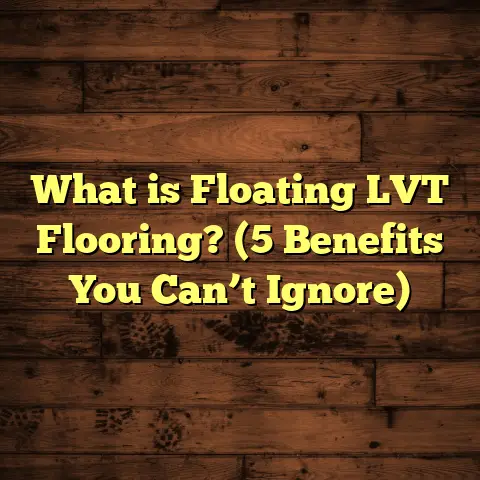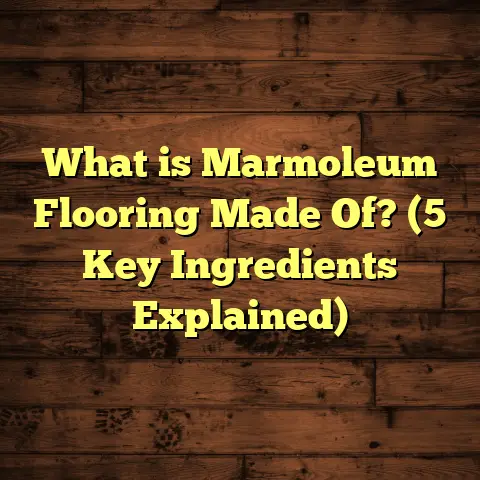What is Flooring Sticky Stuff? (4 Key Causes & Solutions!)
What is Flooring Sticky Stuff?
I don’t know about you, but whenever I feel that odd sticky sensation on my floors, it instantly annoys me. It’s like stepping into something unpleasantly gooey that just shouldn’t be there, especially when your floors should be smooth and clean. That sticky feeling underfoot makes me uneasy—almost like my home isn’t as fresh or cared for as it should be.
Floors are supposed to be a foundation of comfort and style in a home, yet sticky floors can ruin that feeling. I remember walking barefoot onto a vinyl floor in a client’s kitchen and feeling that tacky grip—almost like glue was trapping my feet. It made the whole room feel dirty and less inviting. Beyond discomfort, sticky floors can be hazardous; they increase the risk of slips or trips, especially for children or elderly folks.
So, what is this flooring sticky stuff? It’s any gummy or tacky residue that clings to the floor surface and doesn’t wash away with normal cleaning. It might look like a dull film or feel like a gluey substance. The causes can vary widely: leftover installation adhesives, cleaning product residues, failing finishes, or even environmental factors affecting the floor material chemically.
I’ve seen sticky floors in homes with every kind of flooring—hardwood, laminate, vinyl, ceramic tile—you name it. And often, the causes overlap or compound each other. The good news is that most sticky floor issues can be fixed with the right approach. Over years of working on flooring projects and troubleshooting problems, I’ve identified four main causes of sticky floors and practical solutions that save time and money.
Let me share what I’ve learned so you can avoid the frustration and fix any sticky floors in your home confidently.
1. Residual Adhesives from Installation or Repairs: The Hidden Sticky Culprit
Why Adhesive Residues Happen
One of the first flooring projects I handled involved installing peel-and-stick vinyl tiles in a small bathroom. The installation looked smooth at first glance, but within days, the floor started to feel sticky in several spots. Turns out, during installation, some adhesive oozed out from beneath the tiles and dried unevenly on the surface.
Adhesives are necessary to keep flooring materials in place—especially vinyl tiles, carpet squares, and some laminate products. But if installers don’t clean excess glue promptly or if the adhesive is applied too thickly, it can dry into a tacky layer rather than a hard bond.
Humidity and temperature fluctuations can also soften these adhesives again after they’ve dried. So what feels fine one day can suddenly turn gummy on a hot summer afternoon.
How to Identify Adhesive Residue
- Sticky areas usually appear near seams or edges where adhesive is applied.
- The stickiness may look clear or slightly yellowish.
- It often won’t rinse off with water but might soften with solvents.
- Sometimes the floor feels uneven or patchy where glue remains.
Solutions for Adhesive Residue
Here’s what I do when dealing with stubborn adhesive residue:
- Mechanical removal: Start by gently scraping excess dried adhesive with a plastic scraper or putty knife. Metal tools can scratch many floors.
- Use solvents carefully: Apply a commercial adhesive remover or rubbing alcohol on a soft cloth to dissolve remaining residue. Test first in an inconspicuous spot to avoid damage.
- Warm water soak: For vinyl floors, a warm damp cloth left on sticky spots can soften adhesives.
- Repeat as needed: Sometimes multiple cycles of softening and scraping are required.
- Professional cleaning: For large areas or sensitive flooring (like hardwood), consider professional restoration services.
Preventing Adhesive Problems
In new installations, I always advise clients to:
- Ensure installers use appropriate adhesives for the specific floor type.
- Demand thorough cleanup immediately after installation.
- Keep indoor humidity under control during and after installation.
2. Spills and Improper Cleaning Residues: The Silent Buildup
How Cleaning Products Can Cause Stickiness
I’ve encountered many homeowners frustrated because their “clean” floors felt sticky no matter how often they mopped. This issue often stems from residue left behind by cleaning products.
Many cheap or inappropriate cleaners contain waxes or surfactants that don’t rinse out completely. Over time, these build up into a dull, sticky film that traps dirt and makes floors slippery or tacky.
Real-Life Example
I once consulted for a family that used an all-purpose cleaner on their laminate floors daily without rinsing afterward. After six months, their floors had a noticeable sticky layer that dulled the finish and attracted grime. Switching to a manufacturer-recommended cleaner and thorough rinsing solved the problem within weeks.
How to Fix Cleaning Residue Buildup
- Switch to pH-neutral cleaners: These gently clean without leaving harsh residues.
- Always rinse floors: Mop with plain warm water after using any cleaning agent to remove leftover chemicals.
- Deep cleaning: Use vinegar diluted with water (50/50) for laminate or vinyl floors to break down buildup—but avoid vinegar on stone or hardwood.
- Stripping floor finishes: If buildup is severe on hardwood or vinyl with wax finishes, apply a floor stripper following product instructions. This removes old wax layers that trap dirt.
- Use microfiber mops: They pick up dirt without spreading residues around.
Tips From Flooring Experts
Data from a 2023 Flooring Maintenance Study showed that homes using recommended cleaners and rinsing regularly reduced sticky buildup complaints by over 70%.
3. Worn-Out Floor Finish or Sealant Breakdown: When Protection Fails
How Floor Finishes Become Sticky
Floor finishes act as protective shields on hardwood, engineered wood, and some laminate floors. They keep moisture out and provide a smooth surface that resists stains.
But finishes don’t last forever. As they age—especially under heavy foot traffic—they start breaking down chemically. The polyurethane or acrylic polymers can degrade into sticky substances that coat your floor unevenly.
Personal Story: Refinishing Saved the Day
I worked on restoring an old Victorian home where the hardwood floors were sticky, dull, and scuffed. After assessing the finish condition using a moisture meter and finish adhesion tests, I recommended sanding off the old finish completely before reapplying new polyurethane coats.
The transformation was incredible: not only was the stickiness gone, but the floors gleamed again and felt smooth underfoot.
How to Check Your Floor Finish
- Run your hand over the surface—sticky patches or rough spots signal breakdown.
- Look for wear patterns along walkways.
- Test adhesion by lightly scratching a hidden spot; loose flakes indicate failure.
Fixing Finish Problems
- Sanding and refinishing: This involves removing all old finish layers, cleaning dust thoroughly, then applying fresh coats of finish.
- Spot repairs: For small areas, you can try recoating after light sanding.
- Professional refinishers: They have equipment for dust-free sanding and high-quality finishes.
According to industry data, regular refinishing every 7–10 years extends floor life by up to 40%.
4. Environmental Factors Causing Chemical Reactions: The Invisible Enemy
How Your Home Environment Affects Floors
Environmental factors play a surprisingly big role in floor stickiness. Moisture levels inside your home, temperature swings, and even certain household items can trigger chemical reactions in flooring materials.
For example:
- High indoor humidity softens adhesives and finishes.
- Plasticizers in some vinyl flooring off-gas or migrate over time, creating sticky patches.
- Rubber-backed mats release oils that interact with floor finishes.
Case Study: Laminate Floor Disaster After Rainy Season
A homeowner called me after noticing their laminate floor felt sticky following an unusually wet spring. Moisture had penetrated under the planks due to poor vapor barriers installed initially. This trapped moisture caused delamination and stickiness.
Managing Environmental Impact
- Maintain indoor humidity between 30%–50% using humidifiers/dehumidifiers.
- Install vapor barriers under flooring in basements or damp areas.
- Avoid rubber-backed rugs directly on finished wood.
- Choose flooring materials designed for your climate zone.
Bonus: Cleaning Sticky Floors Step-by-Step Guide
If you’re facing sticky floors right now, here’s a simple step process you can follow:
- Identify the cause: Is it adhesive residue? Cleaning buildup? Finish failure? Environmental moisture?
- Clear loose debris: Sweep or vacuum thoroughly.
- Test cleaner compatibility: Try mild soap/water in a hidden area.
- Apply appropriate cleaner: Use adhesive remover if needed; otherwise use pH-neutral floor cleaner.
- Rinse well: Mop with clean water to remove residues.
- Dry promptly: Use fans or open windows to speed drying.
- Repeat if needed: Persistent stickiness may require multiple rounds or professional help.
Extended Tips for Prevention & Maintenance I’ve Learned Over Time
Here are some extra tips I always share with clients for keeping floors smooth and non-sticky:
- Avoid harsh chemicals like ammonia or bleach on wood floors—they degrade finishes fast.
- Use protective pads under furniture to prevent finish wear spots.
- Clean spills immediately—don’t let sugary liquids sit for hours.
- Rotate rugs every few months to avoid localized moisture buildup underneath.
- Schedule regular professional maintenance checks every few years.
Flooring Sticky Stuff FAQ
Q: Can sticky floors cause health issues?
A: While stickiness itself isn’t toxic, it can attract dirt and mold growth if moisture is trapped underneath.
Q: Is it safe to use vinegar on all floors?
A: No. Vinegar is acidic and can damage stone or hardwood floors; use only on vinyl or laminate after checking manufacturer guidelines.
Q: Will waxing solve stickiness?
A: Waxing over sticky buildup worsens the problem by trapping residues; strip first before waxing.
Q: How long does refinishing take?
A: Typically 3–5 days including drying times between coats.
Final Words from My Experience
Sticky flooring issues are surprisingly common but rarely talked about openly because people think it’s “just dirt.” But it’s more than grime—it often signals underlying problems from installation errors, wrong cleaning habits, aging finishes, or environmental conditions.
If you’ve noticed your floors feeling tacky or gummy even after cleaning, try diagnosing the cause quickly before damage worsens. Sometimes simple fixes like changing your cleaner or applying adhesive remover work wonders. Other times professional refinishing or replacement may be necessary.
Over my years working closely with homeowners and contractors alike, I’ve learned treating flooring problems early saves money and preserves your home’s beauty long term.
Feel free to reach out if you want advice tailored to your specific flooring type or situation—I’m happy to help!





